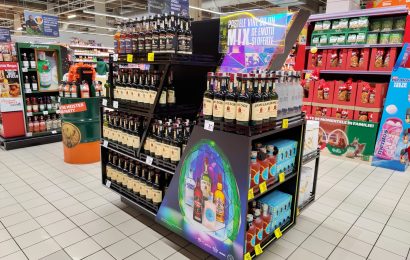WARC Global Advertising Trends: Mobile adspend is set to top TV across key markets this year
Data from WARC’s 12 key markets — Australia, Brazil, Canada, China, France, Germany, India, Italy, Japan, Russia, UK, US — which between them account for three-quarters of global adspend, and 91.1% of all mobile adspend ($125.6bn), show that mobile is currently the second-largest ad medium, and will overtake TV this year if current growth rates are maintained.
Eighty percent of mobile ad market value has been created in the last five years, and the rapid increase in advertiser investment has been driven by a sharp rise in daily mobile internet consumption, driven by social and media platforms.
Research from the 96 markets monitored by WARC shows that 52% of the global population (3.9bn people) access the internet via a mobile phone, with advertisers spending an estimated $137.9bn to reach them last year, or $35.36 per user.
Mobile social and video remain the primary focus for advertisers, as consumer data refines ad targeting
Daily consumption of mobile internet has more than doubled since 2012, increasing by almost two hours to reach 3:14 (h:mm) per day in 2018. Over 90% of this time is spent in-app, and social networking is the most common activity — 51% of Americans visit Facebook several times a day.
Of the 800 senior marketing and advertising practitioners surveyed for WARC’s Marketer’s Toolkit, 71% expect a rise in mobile budgets this year, with most money going to Google- and Facebook-owned platforms.
Nearly all of Facebook’s 1.5bn daily users (one in five people worldwide) access the platform via a mobile. Ad revenues for the company exceeded $50bn last year. Google’s ad income topped $100bn for the first time last year, with much of its recent growth due to mobile search (Google handles 94.1% of all mobile search queries worldwide). Mobile devices already account for over 70% of all YouTube viewing.
Mobile ad growth is being fuelled by the boom in programmatic trade, which leverages consumer data to target ad placements in milliseconds. Almost two-thirds (62.6%) of all digital display adspend was automatically traded by machines in 2018 ($71.5bn, according to Zenith data). This is up from a 35.3% share in 2014, and has trebled since 2013. Paid search and social media on Google and Facebook platforms are programmatic by design.
5G will boost speeds and facilitate a 4x increase in monthly data consumption, as three in four internet users are forecast to be mobile-only
The rollout of 5G, which begins in earnest this year, will facilitate higher connection speeds and data transfer. Approximately 18.4% (1.5bn) of the global population is forecast to have 5G subscription by 2024, and advertisers will be able to reach this audience with high-quality pre/mid/post roll video advertising across a near-instant connection.
In the US, mobile video ad investment is forecast to reach $12.6bn this year, up 37.1% from an estimated $9.2bn in 2018 and equivalent to over two-thirds (67%) of all online video spend in the country. In China, mobile is also set to account for over two-thirds of online video spend, at $5.2bn.
Three quarters (3.7bn) of global internet users will be mobile-only by 2025. China, India, Indonesia, Nigeria and Pakistan are expected to account for half of all growth in mobile users over the period.
Ad viewability and measurement are concerns for practitioners
Viewability and accurate measurement of online ad performance was cited as the biggest concern for 47% of the respondents to WARC’s Marketer’s Toolkit survey. One in five also stated they were unable to measure mobile ROI accurately; most (59%) were uncertain. A similar proportion said the same of social media.
Approximately one in two mobile display (non-video) ads still does not meet the Media Ratings Council (MRC) viewability standard — that at least half the ad be seen for one continuous second.
Mobile video ads fare better by the MRC standard (71.1% meet the grade on average), though these are susceptible to ad blocking when delivered outside an app. One in five mobile internet users across WARC’s key markets reported deploying a mobile ad blocker in the last month.
Consumer data are a highly valuable resource; practitioner attitudes do not square with consumers’
With the introduction of the GDPR coming amid a series of high profile data breaches and an inquiry into Facebook’s handling of its user data, privacy concerns are now at the forefront of digital consumerism.
In the US, where the vast majority of global programmatic ad trade takes place (54.7%, or $39.1bn), almost one in five (18.9%) marketers is ‘not at all worried’ about using consumer data. Over half (56.6%) ranked their level of concern between one and three, indicative of a low level of worry overall.
The results do not align with consumer concerns. Fewer than half of Americans trust social media companies with their personal data, while most (74%) are unaware that Facebook collects data relating to their interests. Almost half (46%) of UK consumers are unsure whether GDPR has been effective.
James McDonald, Data Editor, WARC, summing up, says: “Google- and Facebook-owned apps dominate mobile consumers’ lives, and this duopoly attracted over $150bn last year by pairing advertisers with users based on their data.
“There remains significant uncertainty around mobile effectiveness and ROI — yet there is also little sign advertisers will rethink their spending plans for mobile-first platforms in the coming years. These trends are set to make mobile, in all its forms, the number one ad medium in major markets this year.”






